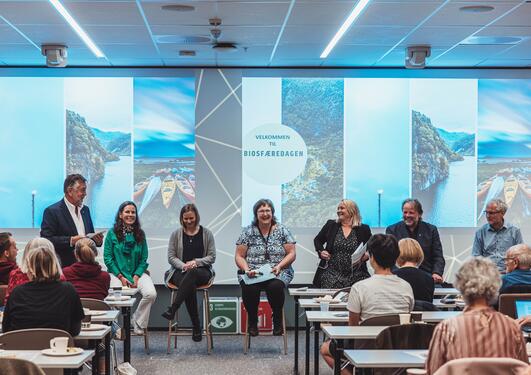The Biosphere Day 2024
For the second time, Nordhordland UNESCO Biosphere hosted the now annual Biosphere Day 30 May 2024. This years’ theme was Green transitions: Energy, land-use pressure and nature in Nordhordland. Politicians, municipal employees, researchers, and businesspeople all attended to discuss the future needs of the region.
Main content
Circular Nordhordland
The day started with the opening of the brand-new exhibition Circular Nordhordland, initiated by the Heathland Centre and created with the help of local resources and people. The goal of the exhibition is to visualize the SDGs in a regional context, the main foci being photosynthesis, life on land, life in the ocean, and energy and industry.
As part of the opening, the mayor of Osterøy, Lars Fjeldstad, had been invited to give a tribute to the “Nordhordlending”. He reminisced about his grandfather, who saved every little piece of wood or metal because it might come in handy one day – as it often also did. The people of Nordhordland have been used to having to utilize what little resources they had, which is an important legacy. But as Lars Fjellstad also emphasized, innovation is also important. ‘We need to have both roots, and wings’, as he put it.
The opening ceremony was complete with a “ribbon cutting” by the student body leaders of Knarvik elementary school, and the ribbon was in fact yarn made of wool from wild sheep. During the next year, the exhibition will travel around all municipalities of the BR, before it resides permanently in the Heathland Center.
Green Transitions in Industry
The main part of the day was the conference titled Green transitions: Energy, land-use pressure and nature in Nordhordland. After an official welcome by Alver mayor Sara Sekkingstad, biosphere coordinator Kari E. Natland opened by introducing the idea of the forward-thinking BR, encouraging collaboration across sectors and fields, and stressing the importance of the support of local businesses.
Associate professor at UiB, Martin Greve came to talk about energy – what it is, and possibilities and challenges with renewable energy. He also emphasized the enormous increase in energy consumption since the industrial revolution, pointing to the fact that we probably will not be able to continue this development.
Further, business representatives from Equinor, Greenspot Mongstad, and Nordhordland Næringsråd (the Business Council of Nordhordland) spoke of future business development in the region, and how to keep it gentle on nature while still being attractive for larger companies.
Nature and Land-Use Pressure
Talk of energy and business development was followed up by viewing things from nature’s perspective; a talk on photosynthesis and carbon by Siri Haugum from the Heathland Center, and a breakdown of the Kunming-Montreal Global Biodiversity Framework, and how to use it as a guide in the energy debate by professor Vigdis Vandvik from UiB.
All of these talks laid the foundation for the following on-stage chat between politicians, businesspeople and researchers: what would be good choices for the future of the BR? The talk focused a lot on nature and land-use, as green transitions can require a lot of land, but the panelists agreed that one way to go is re-using areas in which nature is already “destroyed”, and also having more multipurpose areas – like solar panels on the rooftops in industry areas.
People also agreed that more cooperation is needed between business and the BR for the BR to reach its full potential, but the BR status and concept are still not known well enough in within the citizens of the region. An even more clear purpose, and more awareness is needed. All the more reason to continue with a yearly Biosphere Day; to raise awereness, and keep and enhance colaborations.







